
|
New Zealand and
Botanic Materia Medica
Introduction. Serried rows of early Victorian photographs. Stern eyes in hard faces. Probing the intruder. Stiff backs and iron wills, the requisites to pioneer a new land. From sailing ships and iron ships they poured ashore. The armies of the vanguard whalers. The old days, and the old ways, swept away in a flash flood of progress. The Maori called them �Pakeha� With them came their cultural mores, the technology, and the seeds of plants from the old country. Prominent were the seeds of medicinal plants from Britain and Europe. Things would never be the same again as the white tribes swept across the globe. The New Zealand indigenous flora was unique. Some 80 million years ago the umbilical cord of Mother Gondwanaland was severed and the land stood in splendid isolation. We do not know if there were prior inhabitants before the arrival of the Maori circa 1000CE. We do not know from whence the Maori came. The opinion of the scholars is that the migration route lay along the Malaysian Archipelago.
For anyone that would wish to get a sympathetic understanding
of the cultural anthropology, there are two authors of note. The
earliest is a Pakeha, �Elsdon Best�. Recommended in
particular, is his �Forest Lore of the Maori�.
The Maori had no natural immunity, to the introduced diseases which all but decimated them. They made clear distinction between sickness that had been introduced, which they called �Mate Pakeha�, and their own ills which were called �Mate Maori�. It is most regrettable, that many of the earlier, and sometime more modern authors when commenting on medical matters as it touched the Maori, were less than sympathetic. They are only distinguished by the authors own obvious prejudice. It is my personal experience, that unless one has the trust of the Maori informant in such matters, then one will be fed a bucket of tripe. One needs to live with the Maori for a while in order to distinguish between tripe and substance. Many of the plant remedies used by the Maori, were in the main, used externally, either as steam baths, poultices or crude ointments. The methods of preparation for medical purposes, were quick and simple. Materials for use would either be chewed to a paste first, or pounded between stones. Infusions were also made by dropping heated stones into a calabash containing plant parts and water. They made use of steam baths hot pools, there is some anecdotal evidence that states, 'when perfumes were made, that a considerable sophistication was shown in the method of preparation'. Quite so, the method they used was called enfleurage. I would also mention in passing, of knowledge extant before the arrival of the white tribes. The poisonous Karaka berries enclosed in flax containers, then submerged in running water, which slowly leached and washed away the toxic skin and flesh. What are we to make of the later introduction of maize which was treated by allowing the maize to ferment. (Kanga) The resulting porridge when eaten is said to be a natural contraceptive. Be warned you need a blocked nose and strong stomach. Whence came this knowledge ? Graduates of the Whare Wananga, the nobles and priests, were possessed of a higher form of knowledge to that of the common peoples. A careful study of the works of Elsdon Best and Te Rangi Hiroa will give hints of the depth and intensity of the Maori perception of the natural world. A Shaman of any culture, will recognise as brother, the Maori Tohunga.
This knowledge was adopted by the Maori, who also commenced to experiment with many of the native trees and plants. There was little or no uniform plant usage, each tribe had its own customs and tradition, upon which they drew. In those early days, New Zealand attracted many people who had received a scientific training, knowledge that this fledgling nation needed, if it were to succeed in the wider world. Of great importance to the health of the growing nation, were the Doctors, Pharmacists, Chemists and Botanists. They were proficient with the European medicinal plants, and proceeded to unravel the bewildering profusion of the endemic species. Pharmacists in particular, generated considerable trade within New Zealand for their simples and compounds, all made from the endemic plants. Of particular note in the realm of pharmacy, was �Mother Mary Joseph Aubert, a French Nun. Mother Mary Joseph Aubert (1835-1926) Mother Aubert was invited to New Zealand by the Roman Catholic Bishop, Pompallier, in 1860. In 1908, she opened the Library of Compassion at Island Bay in Wellington. Apparently, she had to enlist the aid of local doctors. To their shame, these medical men insisted that in return for their aid, Mother Aubert would have to forsake the herbs and destroy her formulae. The archives of Our Lady's Library of Compassion, Island Bay, Wellington, contain a few of her surviving manuscripts. Of particular interest is a letter in the New Zealand Department of Health files (dated 1924), which was addressed to Dr. Valentine, the then Director General of Health., in which, Mother Aubert claims, that in 1876, she cured a Maori woman of what a Doctor Spencer diagnosed as Leprosy. Doctor Spencer, an ex Mayor of Napier, submitted a full report to the British Medical Journal, the Lancet. Regrettably, it would appear that the report was never published. Her renowned herbal formulae were destroyed in the early 1900,s. Some few bottles of her herbal tinctures still survive. It is unfortunate that they will have now deteriorated to such an extent, that they are beyond accurate analysis. Four of those remedies are as follows :Natanata. Possibly containing karamu, koromiko, miro, pukatea, rata, tanekaha, tawa. Used for general constitution, diarrhoea, vomiting, stomach ache. Marupa. Possibly containing houhere, kareao, kawakawa, manuka, pinatoro, rata, tarata, tawa. Used for all bronchial infections. Paramo. Possibly containing harakeke, kareao, kawakawa, manuka. Used for kidney and liver problems, blood cleanser, vermifuge, laxative Karana. Possibly containing horopito or kohekohe, kareao, kowhai, pinatoro, pohutukawa, titoki. Used to treat chronic stomach illness, anaemia, diarrhoea, debility, fever. Since that time, the investigation and incorporation of plants, into a NZ Herbal Materia Medica has proceeded along two parallel roads. The first road is the �Eclectic Empiric� road. Which has served us well since the beginning of time.
Also of note: Antibiotic compounds from New Zealand plants. Ill: a survey of some New Zealand plants for antibiotic substances. Victoria L. Calder, A.L.J. Cole and J.R.L. Walker* Extracts from the leaves of over two hundred New Zealand native plants have been assayed for antibiotic activity against a range of bacteria, yeasts and fungi. New Zealand Plants in Medical Literature. There are 3 plants of note, firstly Koromiko. The abstracted monograph is reproduced from �New Zealand Medicinal Plants by Booker, Cambie and Cooper.
Hebe salicifolia (Forst.f.) Penn. and similar
species. BOTANICAL NOTES: All of these
authors regarded the species known
as V. salicifolia, as a population of many forms, growing in both
the North and South Islands.
MEDICAL USE: The plant was used in vapour baths in early times. An infusion of the leaves was a powerful astringent for dysentery and other complaints. The decoction was also taken for ulcers and for venereal disease. Bruised leaves were applied as poultices for ulcers, especially for venereal disease. A weak infusion was a tonic, and a small portion of the leaf, if chewed, soon produced .a keen sense of hunger. Koromiko has long been valued for its beneficial effects in cases of diarrhoea and dysentery, and in 1889, Kirk predicted that it would take its place in the pharmacopoeia, as a recognised remedy for diseases of this class. In 1895, it was indeed listed in the Extra Pharmacopoeia as an import from New Zealand, used there and in China, as a remedy for chronic dysentery and diarrhoea. Tincture, 1 in 5 of proof spirits. Dose � to 1 drachm. It was deleted from later editions. The leaves were used for sores and headaches and as a pack for sore skin in infants. The liquid from boiling the leaves was used as a mouthwash and gargle. Bushmen troubled with English cholera frequently treated the disease by chewing fresh leaves of the plant and swallowing the juice, but usually the drug was taken in the form of an infusion. It was kept in stock by the leading druggists in the colony. The leaves were chewed as a remedy for diarrhoea; An infusion or spirituous decoction was useful in dealing with epidemic infantile diarrhoea. The plant was used by both settlers and Maori. Fresh young leaves were pounded and boiled with water, and the filtered a decoction was effective, but an infusion of dried leaves was not. The sap was used for a children's skin disease called 'hawaniwani'. Top shoots and young leaves, either boiled green, dried and later boiled, or eaten raw, were a remedy for dysentery and summer sickness. They were also used for kidney and bladder troubles. During the Second World War, the leaves were found effective for dysentery by the New Zealand troops in North Africa. Several authors state that Sir Peter Buck first used it during the First World War, but he had no knowledge of its use at that time(1etter to DSIR). Koromiko was used as a blood purifier by the Rev. Edgar Ward.
|
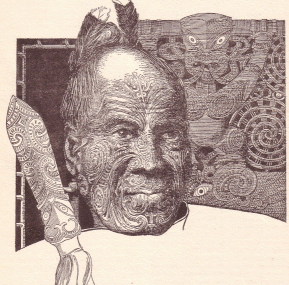
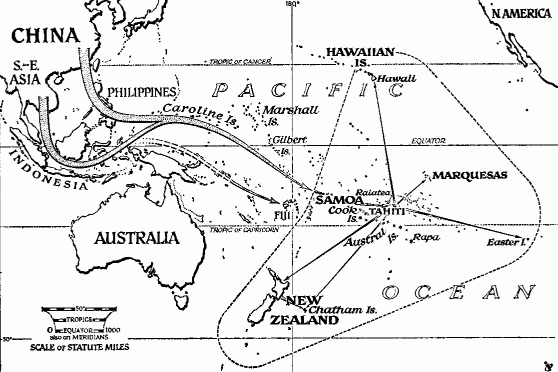
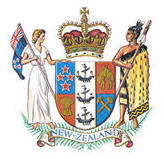 The
Arrival of the Pakeha
The
Arrival of the Pakeha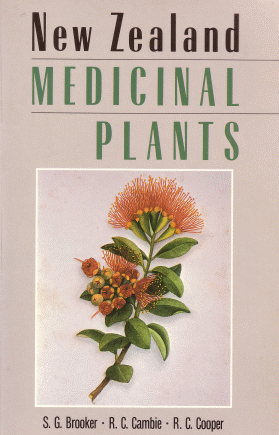 The second road, but not the least, is
the road of Science. In that respect, I have no hesitation in
recommending NZ Medicinal Plants, a book written by Scientists. It
is scholarly but highly readable. A masterly blend of tradition and
science, and well illustrated. It contains 534 citations, a glossary
and a good index to the plants.
The second road, but not the least, is
the road of Science. In that respect, I have no hesitation in
recommending NZ Medicinal Plants, a book written by Scientists. It
is scholarly but highly readable. A masterly blend of tradition and
science, and well illustrated. It contains 534 citations, a glossary
and a good index to the plants.
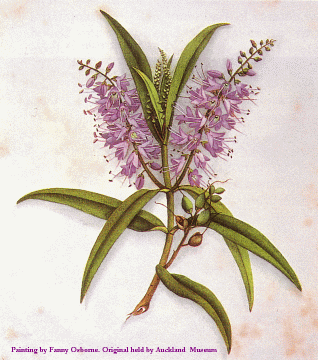 Hebe
sp.
Hebe
sp.